Lexus ES: A/F (O2) Sensor Signal Biased/Stuck Lean Bank 1 Sensor 1 Circuit Current Above Threshold (P219519,P219524,P219618,P219623,P219719,P219724,P219818,P219823)
DESCRIPTION
HINT:
Although the DTC titles say oxygen sensor, these DTCs relate to the air fuel ratio sensor.
The air fuel ratio sensor generates voltage* that corresponds to the actual air fuel ratio. This sensor voltage is used to provide the ECM with feedback so that it can control the air fuel ratio. The ECM determines the deviation from the stoichiometric air fuel ratio level, and regulates the fuel injection duration. If the air fuel ratio sensor malfunctions, the ECM is unable to control the air fuel ratio accurately.
The air fuel ratio sensor is a planar type and integrated with the heater, which heats the solid electrolyte (zirconia element). This heater is controlled by the ECM. When the intake air volume is low (the exhaust gas temperature is low), a current flows into the heater to heat the sensor, in order to facilitate accurate oxygen concentration detection. In addition, the sensor and heater portions are a narrow type. The heat generated by the heater is conducted to the solid electrolyte through the alumina, therefore sensor activation is accelerated.
In order to obtain a high purification rate of the carbon monoxide (CO), hydrocarbon (HC) and nitrogen oxide (NOx) components in the exhaust gas, a three-way catalytic converter is used. For the most efficient use of the three-way catalytic converter, the air fuel ratio must be precisely controlled so that it is always close to the stoichiometric level.
*: Value changes inside the ECM. Since the air fuel ratio sensor is a current output element, the current is converted into a voltage inside the ECM. Any measurements taken at the air fuel ratio sensor or ECM connectors will show a constant voltage.
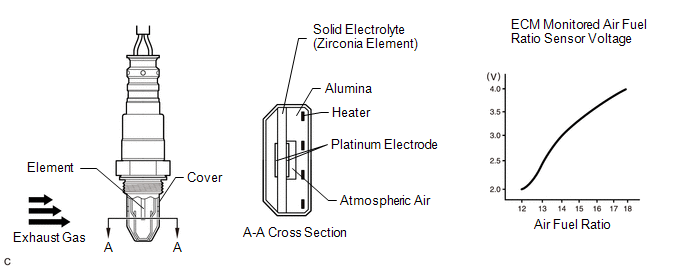
| DTC No. | Detection Item | DTC Detection Condition | Trouble Area | MIL | Memory | Note |
|---|---|---|---|---|---|---|
| P219519 | A/F (O2) Sensor Signal Biased/Stuck Lean Bank 1 Sensor 1 Circuit Current Above Threshold | While the fuel-cut operation is performed (during vehicle deceleration), the air fuel ratio sensor current is 2.2 mA or higher for 3 seconds or more (2 trip detection logic). |
| Comes on | DTC stored | SAE Code: P2195 |
| P219524 | A/F (O2) Sensor Signal Biased/Stuck Lean Bank 1 Sensor 1 Signal Stuck High | Both of the following conditions are met for 5 seconds or more (2 trip detection logic):
|
| Comes on | DTC stored | SAE Code: P2195 |
| P219618 | A/F (O2) Sensor Signal Biased/Stuck Rich Bank 1 Sensor 1 Circuit Current Below Threshold | While the fuel-cut operation is performed (during vehicle deceleration), the air fuel ratio sensor current is less than 0.47 mA for 3 seconds or more (2 trip detection logic). |
| Comes on | DTC stored | SAE Code: P2196 |
| P219623 | A/F (O2) Sensor Signal Biased/Stuck Rich Bank 1 Sensor 1 Signal Stuck Low | Both of the following conditions are met for 5 seconds or more (2 trip detection logic):
|
| Comes on | DTC stored | SAE Code: P2196 |
| P219719 | A/F (O2) Sensor Signal Biased/Stuck Lean Bank 2 Sensor 1 Circuit Current Above Threshold | While the fuel-cut operation is performed (during vehicle deceleration), the air fuel ratio sensor current is 2.2 mA or higher for 3 seconds or more (2 trip detection logic). |
| Comes on | DTC stored | SAE Code: P2197 |
| P219724 | A/F (O2) Sensor Signal Biased/Stuck Lean Bank 2 Sensor 1 Signal Stuck High | Both of the following conditions are met for 5 seconds or more (2 trip detection logic):
|
| Comes on | DTC stored | SAE Code: P2197 |
| P219818 | A/F (O2) Sensor Signal Biased/Stuck Rich Bank 2 Sensor 1 Circuit Current Below Threshold | While the fuel-cut operation is performed (during vehicle deceleration), the air fuel ratio sensor current is less than 0.47 mA for 3 seconds or more (2 trip detection logic). |
| Comes on | DTC stored | SAE Code: P2198 |
| P219823 | A/F (O2) Sensor Signal Biased/Stuck Rich Bank 2 Sensor 1 Signal Stuck Low | Both of the following conditions are met for 5 seconds or more (2 trip detection logic):
|
| Comes on | DTC stored | SAE Code: P2198 |
HINT:
- DTCs P219519, P219524, P219618 and P219623 indicate malfunctions related to the bank 1 air fuel ratio sensor circuit.
- DTCs P219719, P219724, P219818 and P219823 indicate malfunctions related to the bank 2 air fuel ratio sensor circuit.
- When any of these DTCs are stored, check the air fuel ratio sensor voltage output by entering the following menus on the Techstream: Powertrain / Engine / Data List / A/F (O2) Sensor Voltage B1S1 or A/F (O2) Sensor Voltage B2S1.
- Short-term fuel trim values can also be read using the Techstream.
- The ECM regulates the voltages at the A1A+, A2A+, A1A- and A2A- terminals of the ECM to a constant level. Therefore, the air fuel ratio sensor output voltage cannot be confirmed without using the Techstream.
- If an air fuel ratio sensor malfunction is detected, the ECM will store a DTC.
MONITOR DESCRIPTION
Sensor Voltage Detection Monitor:Under air fuel ratio feedback control, If the air fuel ratio sensor output voltage is less than 2.8 V (very rich condition) for 5 seconds despite the heated oxygen sensor output voltage being less than 0.7 V, the ECM stores DTC P219623 or P219823. Alternatively, if the air fuel ratio sensor output voltage is higher than 3.8 V (very lean condition) for 5 seconds despite the heated oxygen sensor output voltage being 0.21 V or higher, DTC P219524 or P219724 is stored.
Sensor Current Detection Monitor:A rich air fuel mixture causes a low air fuel ratio sensor current, and a lean air fuel mixture causes a high air fuel ratio sensor current. Therefore, the sensor output becomes low during acceleration, and it becomes high during deceleration with the throttle valve fully closed. The ECM monitors the air fuel ratio sensor current during fuel-cut and detects any abnormal current values.
If the air fuel ratio sensor output is 2.2 mA or higher for 3 seconds or more of cumulative time, the ECM interprets this as a malfunction in the air fuel ratio sensor and stores DTC P219519 or P219719 (stuck on high side). If the air fuel ratio sensor output is less than 0.47 mA for 3 seconds or more of cumulative time, the ECM stores DTC P219618 or P219818 (stuck on low side).
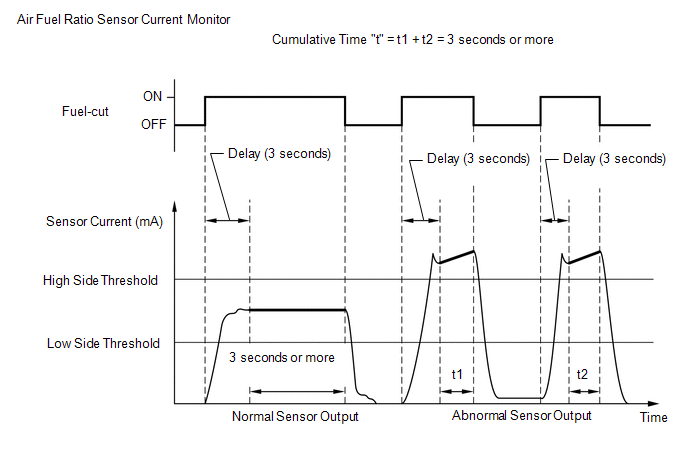
MONITOR STRATEGY
| Related DTCs | P2195: Air fuel ratio sensor (bank 1) signal stuck lean P2196: Air fuel ratio sensor (bank 1) signal stuck rich P2197: Air fuel ratio sensor (bank 2) signal stuck lean P2198: Air fuel ratio sensor (bank 2) signal stuck rich |
| Required Sensors/Components (Main) | Air fuel ratio sensor |
| Required Sensors/Components (Related) | Heated oxygen sensor |
| Frequency of Operation | Continuous: Sensor voltage detection monitor Once per driving cycle: Sensor current detection monitor |
| Duration | 3 seconds: Sensor current detection monitor 5 seconds: Sensor voltage detection monitor |
| MIL Operation | 2 driving cycles |
| Sequence of Operation | None |
TYPICAL ENABLING CONDITIONS
All| Monitor runs whenever the following DTCs are not stored | P0010, P0020 (VVT oil control solenoid bank 1, 2) P0011, P0021 (VVT system bank 1, 2 - advance) P0012, P0022 (VVT system bank 1, 2 - retard) P0013, P0023 (Exhaust VVT oil control solenoid bank 1, 2) P0014, P0024 (Exhaust VVT system bank 1, 2 - advance) P0015, P0025 (Exhaust VVT system bank 1, 2 - retard) P0016, P0018 (VVT system bank 1, 2 - misalignment) P0017, P0019 (Exhaust VVT system bank 1, 2 - misalignment) P0031, P0032, P0051, P0052, P101D, P103D (Air fuel ratio sensor heater) P0037, P0038, P0057, P0058, P0141, P0161, P102D, P105D (Heated oxygen sensor heater) P0087, P0088, P0191, P0192, P0193 (Fuel pressure sensor (for high pressure side)) P00FE, P0441 (EVAP system) P0101, P0102, P0103 (Mass air flow meter) P0111, P0112, P0113 (Intake air temperature sensor) P0116, P0117, P0118 (Engine coolant temperature sensor) P011B (Engine coolant temperature/intake air temperature sensor correlation) P0121, P0122, P0123, P0222, P0223, P2135 (Throttle position sensor) P0125 (Insufficient coolant temperature for closed loop fuel control) P0128 (Thermostat) P0136, P0137, P0138, P0139, P013A, P013C, P0156, P0157, P0158, P0159, P0607 (Heated Oxygen Sensor) P0171, P0172, P0174, P0175 (Fuel system) P0201, P0202, P0203, P0204, P0205, P0206, P062D, P21CF, P21D0, P21D1, P21D2, P21D3, P21D4 (Fuel injector) P0300 - P0306 (Misfire) P0327, P0328, P0332, P0333 (Knock control sensor) P0335, P0337, P0338 (Crankshaft position sensor) P0340, P0342, P0343, P0345, P0347, P0348 (Camshaft position sensor) P0351 - P0356 (Igniter) P0365, P0367, P0368, P0390, P0392, P0393 (Exhaust camshaft position sensor) P0500 (Vehicle speed sensor) P0657, P2102, P2103, P2111, P2112, P2119 (Throttle actuator) P107B, P107C, P107D (Fuel pressure sensor (for low pressure side)) P11EA, P11EB, P11EC, P11ED, P11EE, P11EF, P11F0, P11F1, P219A, P219B, P219C, P219D, P219E, P219F, P21A0, P21A1 (Air-fuel ratio imbalance) P1235 (High pressure fuel pump circuit) |
| Time after engine start | 30 seconds or more |
| Battery voltage | 11 V or higher |
| Air fuel ratio sensor status | Activated |
| Fuel system status | Closed-loop |
| Battery voltage | 11 V or higher |
| Engine coolant temperature | 75°C (167°F) or higher |
| Atmospheric pressure | 76 kPa(abs) [11 psi(abs)] or higher |
| Air fuel ratio sensor status | Activated |
| Continuous time of fuel-cut | 3 seconds or more, and less than 10 seconds |
TYPICAL MALFUNCTION THRESHOLDS
P2195 and P2197: Sensor Voltage Detection Monitor (Lean Side Malfunction)| Heated oxygen sensor voltage | 0.21 V or higher |
| Air fuel ratio sensor voltage | Higher than 3.8 V |
| Heated oxygen sensor voltage | Less than 0.71 V |
| Air fuel ratio sensor voltage | Less than 2.8 V |
| Duration of following condition | 3 seconds or more |
| Air fuel ratio sensor current | 2.2 mA or higher |
| Duration of following condition | 3 seconds or more |
| Air fuel ratio sensor current | Less than 0.47 mA |
MONITOR RESULT
Refer to detailed information in Checking Monitor Status.
Click here .gif)
| Monitor ID | Test ID | Scaling | Unit | Description |
|---|---|---|---|---|
| $01 | $91 | Multiply by 0.004 | mA | A/F sensor current |
| Monitor ID | Test ID | Scaling | Unit | Description |
|---|---|---|---|---|
| $05 | $91 | Multiply by 0.004 | mA | A/F sensor current |
CONFIRMATION DRIVING PATTERN
HINT:
-
After repair has been completed, clear the DTC and then check that the vehicle has returned to normal by performing the following All Readiness check procedure.
Click here
.gif)
-
When clearing the permanent DTCs, refer to the "CLEAR PERMANENT DTC" procedure.
Click here
.gif)
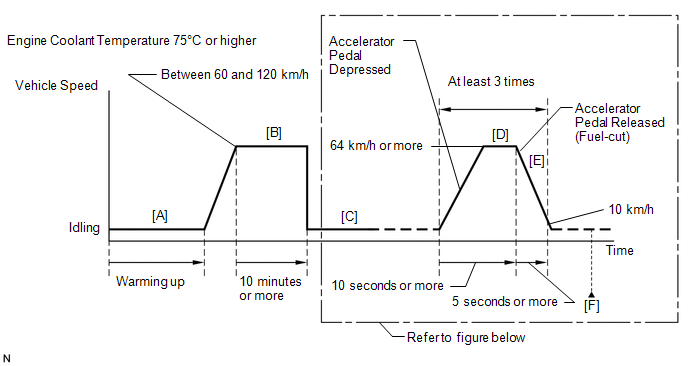
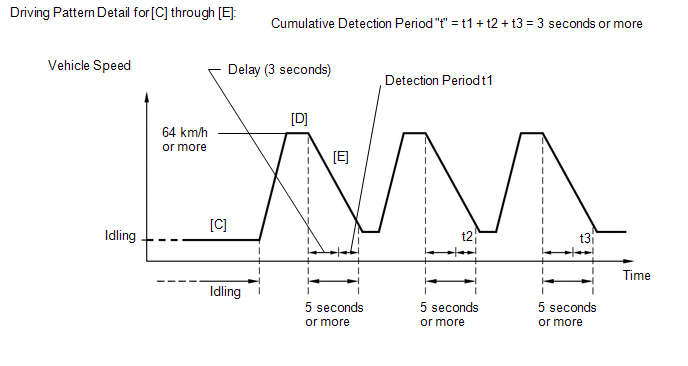
- Connect the Techstream to the DLC3.
- Turn the engine switch on (IG).
- Turn the Techstream on.
- Clear the DTCs (even if no DTCs are stored, perform the clear DTC procedure).
- Turn the engine switch off and wait for at least 30 seconds.
- Turn the engine switch on (IG).
- Turn the Techstream on.
- Start the engine and warm it up until the engine coolant temperature reaches 75°C (167°F) or higher [A].
-
Drive the vehicle at a speed between 60 and 120 km/h (37 and 75 mph) for at least 10 minutes [B].
CAUTION:
When performing the confirmation driving pattern, obey all speed limits and traffic laws.
-
With the shift lever in S [C], accelerate the vehicle to 64 km/h (40 mph) or more by depressing the accelerator pedal for at least 10 seconds [D].
CAUTION:
When performing the confirmation driving pattern, obey all speed limits and traffic laws.
- Soon after performing step [D] above, release the accelerator pedal for at least 5 seconds without depressing the brake pedal in order to execute fuel-cut control [E].
- Allow the vehicle to decelerate until the vehicle speed decreases to less than 10 km/h (6 mph).
- Repeat steps [C] through [E] above at least 3 times in one driving cycle.
- Enter the following menus: Powertrain / Engine / Trouble Codes [F].
-
Read the pending DTCs.
HINT:
- If a pending DTC is output, the system is malfunctioning.
- If a pending DTC is not output, perform the following procedure.
- Enter the following menus: Powertrain / Engine / Utility / All Readiness.
- Input the DTC: P219519, P219524, P219618, P219623, P219719, P219724, P219818 or P219823.
-
Check the DTC judgment result.
Techstream Display
Description
NORMAL
- DTC judgment completed
- System normal
ABNORMAL
- DTC judgment completed
- System abnormal
INCOMPLETE
- DTC judgment not completed
- Perform driving pattern after confirming DTC enabling conditions
HINT:
- If the judgment result is NORMAL, the system is normal.
- If the judgment result is ABNORMAL, the system has a malfunction.
- If the judgment result is INCOMPLETE, perform steps [B] through [F] again.
-
[A] to [F]: Normal judgment procedure.
The normal judgment procedure is used to complete DTC judgment and also used when clearing permanent DTCs.
- When clearing the permanent DTCs, do not disconnect the cable from the battery terminal or attempt to clear the DTCs during this procedure, as doing so will clear the universal trip and normal judgment histories.
WIRING DIAGRAM
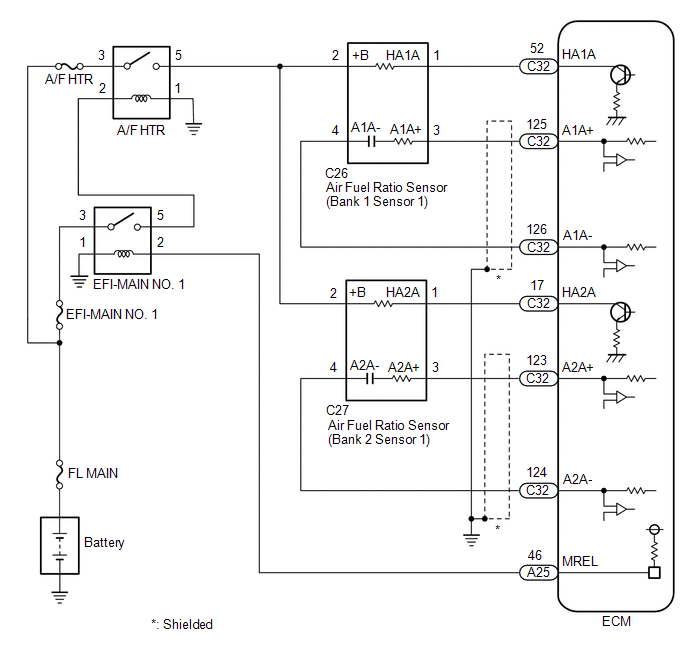
CAUTION / NOTICE / HINT
NOTICE:
Inspect the fuses for circuits related to this system before performing the following procedure.
HINT:
- A low air fuel ratio sensor voltage could be caused by a rich air fuel mixture. Check for conditions that would cause the engine to run rich.
- A high air fuel ratio sensor voltage could be caused by a lean air fuel mixture. Check for conditions that would cause the engine to run lean.
-
Bank 1 refers to the bank that includes the No. 1 cylinder*.
*: The No. 1 cylinder is the cylinder which is farthest from the transaxle.
- Bank 2 refers to the bank that does not include the No. 1 cylinder.
- Sensor 1 refers to the sensor closest to the engine assembly.
- Sensor 2 refers to the sensor farthest away from the engine assembly.
- Read freeze frame data using the Techstream. The ECM records vehicle and driving condition information as freeze frame data the moment a DTC is stored. When troubleshooting, freeze frame data can help determine if the vehicle was moving or stationary, if the engine was warmed up or not, if the air fuel ratio was lean or rich, and other data from the time the malfunction occurred.
PROCEDURE
| 1. | CHECK ANY OTHER DTCS OUTPUT (IN ADDITION TO DTC P219519, P219524, P219618, P219623, P219719, P219724, P219818 OR P219823) |
(a) Connect the Techstream to the DLC3.
(b) Turn the engine switch on (IG).
(c) Turn the Techstream on.
(d) Enter the following menus: Powertrain / Engine / Trouble Codes.
(e) Read the DTCs.
Powertrain > Engine > Trouble Codes| Result | Proceed to |
|---|---|
| DTC P219519, P219524, P219618, P219623, P219719, P219724, P219818 or P219823 is output | A |
| DTC P219519, P219524, P219618, P219623, P219719, P219724, P219818 or P219823 and P013611, P013613, P013614, P013615, P013617, P013623, P015611, P015613, P015614, P015615, P015617 or P015623 are output | |
| DTC P219519, P219524, P219618, P219623, P219719, P219724, P219818 or P219823 and other DTCs are output | B |
HINT:
If any DTCs relating to the air fuel ratio sensor (DTCs for the air fuel ratio sensor heater or air fuel ratio sensor admittance) are output, troubleshoot those DTCs first.
| B | .gif) | GO TO DTC CHART |
|
| 2. | CONFIRM IF VEHICLE HAS RUN OUT OF FUEL IN PAST |
(a) Has the vehicle run out of fuel in the past?
| NO | .gif) | GO TO STEP 5 |
|
| 3. | CLEAR DTC |
(a) Connect the Techstream to the DLC3.
(b) Turn the engine switch on (IG).
(c) Turn the Techstream on.
(d) Clear the DTC.
Powertrain > Engine > Clear DTCs(e) Turn the engine switch off and wait for at least 30 seconds.
|
| 4. | CHECK WHETHER DTC OUTPUT RECURS (DTC P219519, P219524, P219618, P219623, P219719, P219724, P219818 OR P219823) |
(a) Drive the vehicle in accordance with the driving pattern described in Confirmation Driving Pattern.
(b) Enter the following menus: Powertrain / Engine / Utility / All Readiness.
Powertrain > Engine > Utility| Tester Display |
|---|
| All Readiness |
(c) Input the DTC: P219519, P219524, P219618, P219623, P219719, P219724, P219818 or P219823.
(d) Check the DTC judgment result.
| Result | Proceed to |
|---|---|
| NORMAL (DTCs are not output) | A |
| ABNORMAL (DTC P219519, P219524, P219618, P219623, P219719, P219724, P219818 or P219823 is output) | B |
| A | .gif) | DTC CAUSED BY RUNNING OUT OF FUEL |
| B | .gif) | GO TO STEP 5 |
| 5. | CLEAR DTC |
(a) Connect the Techstream to the DLC3.
(b) Turn the engine switch on (IG).
(c) Turn the Techstream on.
(d) Clear the DTC.
Powertrain > Engine > Clear DTCs(e) Turn the engine switch off and wait for at least 30 seconds.
|
| 6. | READ VALUE USING TECHSTREAM (TEST VALUE OF AIR FUEL RATIO SENSOR) |
(a) Drive the vehicle in accordance with the driving pattern described in Confirmation Driving Pattern.
(b) Enter the following menus: Powertrain / Engine / Monitor / Current Monitor / O2 Sensor / Current.
Powertrain > Engine > Monitor(c) Check that the status of O2 Sensor is Complete. If the status is still Incomplete, drive the vehicle according to the driving pattern again.
(d) Enter the following menus: Powertrain / Engine / Monitor / Current Monitor / O2 Sensor / Details / RANGE B1S1 or RANGE B2S1.
Powertrain > Engine > Monitor(e) Check the test value of the air fuel ratio sensor output current during fuel-cut.
| Test Value | Proceed to |
|---|---|
| Within normal range (0.47 mA or higher, and less than 2.2 mA) | A |
| Outside normal range (Less than 0.47 mA, or 2.2 mA or higher) | B |
| B | .gif) | GO TO STEP 18 |
|
| 7. | PERFORM ACTIVE TEST USING TECHSTREAM (CONTROL THE INJECTION VOLUME FOR A/F SENSOR) |
(a) Connect the Techstream to the DLC3.
(b) Turn the engine switch on (IG).
(c) Turn the Techstream on.
(d) Start the engine and warm it up until the engine coolant temperature reaches 75°C (167°F) or higher.
(e) Warm up the air fuel ratio sensor at an engine speed of 2500 rpm for 90 seconds.
(f) Enter the following menus: Powertrain / Engine / Active Test / Control the Injection Volume for A/F Sensor / Data List / Coolant Temperature, A/F (O2) Sensor Voltage B1S1 and O2 Sensor Voltage B1S2 or A/F (O2) Sensor Voltage B2S1 and O2 Sensor Voltage B2S2.
Powertrain > Engine > Active Test| Active Test Display |
|---|
| Control the Injection Volume for A/F Sensor |
| Data List Display |
|---|
| Coolant Temperature |
| A/F (O2) Sensor Voltage B1S1 |
| A/F (O2) Sensor Voltage B2S1 |
| O2 Sensor Voltage B1S2 |
| O2 Sensor Voltage B2S2 |
(g) Perform the Control the Injection Volume for A/F Sensor operation with the engine idling.
(h) Monitor the output voltages of the air fuel ratio and heated oxygen sensors (A/F (O2) Sensor Voltage B1S1 and O2 Sensor Voltage B1S2 or A/F (O2) Sensor Voltage B2S1 and O2 Sensor Voltage B2S2) displayed on the Techstream.
HINT:
- The Control the Injection Volume for A/F Sensor operation lowers the fuel injection volume by 12.5% or increases the injection volume by 12.5%.
- The air fuel ratio sensor has an output delay of a few seconds and the heated oxygen sensor has a maximum output delay of approximately 20 seconds.
- If the sensor output voltage does not change (almost no reaction) while performing the Active Test, the sensor may be malfunctioning.
Standard:
| Techstream Display (Sensor) | Injection Volume | Status | Voltage |
|---|---|---|---|
| A/F (O2) Sensor Voltage B1S1 A/F (O2) Sensor Voltage B2S1 (Air fuel ratio) | 12.5% | Rich | Below 3.1 V |
| -12.5% | Lean | Higher than 3.4 V | |
| O2 Sensor Voltage B1S2 O2 Sensor Voltage B2S2 (Heated oxygen) | 12.5% | Rich | Higher than 0.55 V |
| -12.5% | Lean | Below 0.4 V |
| Status of A/F (O2) Sensor Voltage B1S1 or A/F (O2) Sensor Voltage B2S1 | Status of O2 Sensor Voltage B1S2 or O2 Sensor Voltage B2S2 | Air Fuel Ratio Condition and Air Fuel Ratio Sensor Condition | Proceed to |
|---|---|---|---|
| Lean | Lean | Actual air fuel ratio lean | A |
| Rich | Rich | Actual air fuel ratio rich | |
| Lean | Lean/Rich | Air fuel ratio sensor malfunction | B |
| Rich | Lean/Rich | Air fuel ratio sensor malfunction | |
| Lean/Rich | Lean/Rich | Normal |
- Lean: During the Control the Injection Volume for A/F Sensor of the Active Test, the air fuel ratio sensor output voltages (A/F (O2) Sensor Voltage B1S1 and A/F (O2) Sensor Voltage B2S1) are consistently higher than 3.4 V, and the heated oxygen sensor output voltages (O2 Sensor Voltage B1S2 and O2 Sensor Voltage B2S2) are consistently below 0.4 V.
- Rich: During the Control the Injection Volume for A/F Sensor of the Active Test, the A/F (O2) Sensor Voltage B1S1 and A/F (O2) Sensor Voltage B2S1 are consistently below 3.1 V, and the O2 Sensor Voltage B1S2 and O2 Sensor Voltage B2S2 are consistently higher than 0.55 V.
- Lean/Rich: During Control the Injection Volume for A/F Sensor of the Active Test, the output voltage of the air fuel ratio sensor or heated oxygen sensor alternates correctly.
HINT:
Refer to "Data List / Active Test" [A/F (O2) Sensor Voltage B1S1, A/F (O2) Sensor Voltage B2S1, O2 Sensor Voltage B1S2 and O2 Sensor Voltage B2S2].
Click here .gif)
.gif)
.gif)
| B | .gif) | GO TO STEP 18 |
|
| 8. | CHECK INTAKE SYSTEM |
(a) Check the intake system for vacuum leaks.
Click here .gif)
OK:
No leaks in the intake system.
HINT:
Perform "Inspection After Repair" after repairing or replacing the intake system.
Click here .gif)
.gif)
| NG | .gif) | REPAIR OR REPLACE INTAKE SYSTEM |
|
| 9. | CHECK FOR EXHAUST GAS LEAK |
(a) Check for exhaust gas leaks.
OK:
No gas leaks in exhaust system.
HINT:
Perform "Inspection After Repair" after repairing or replacing the exhaust system.
Click here .gif)
.gif)
| NG | .gif) | REPAIR OR REPLACE EXHAUST SYSTEM |
|
| 10. | CHECK FUEL PRESSURE (FOR LOW PRESSURE SIDE) |
(a) Check the fuel pressure (for low pressure side).
Click here .gif)
| NG | .gif) | GO TO STEP 17 |
|
| 11. | INSPECT PORT FUEL INJECTOR ASSEMBLY |
(a) Inspect the port fuel injector assembly (whether fuel volume is high or low, and whether injection pattern is poor).
Click here .gif)
HINT:
Perform "Inspection After Repair" after replacing the port fuel injector assembly.
Click here .gif)
.gif)
| NG | .gif) | REPLACE PORT FUEL INJECTOR ASSEMBLY |
|
| 12. | READ VALUE USING TECHSTREAM (FUEL PRESSURE (HIGH)) |
(a) Connect the Techstream to the DLC3.
(b) Start the engine.
(c) Turn the Techstream on.
(d) Enter the following menus: Powertrain / Engine / Data List / Engine Speed, Coolant Temperature, Fuel Pressure (High) and Injection Mode.
Powertrain > Engine > Data List| Tester Display |
|---|
| Engine Speed |
| Coolant Temperature |
| Fuel Pressure (High) |
| Injection Mode |
(e) Start the engine and warm it up until the engine coolant temperature is 75°C (167°F) or higher with all the accessories switched off.
(f) According to the display on the Techstream, read the Data List.
Standard:
| Techstream Display | Condition | Specified Condition |
|---|---|---|
| Fuel Pressure (High) |
| 2400 to 20000 kPag |
| NG | .gif) | REPAIR OR REPLACE FUEL SYSTEM (FOR HIGH PRESSURE SIDE) |
|
| 13. | INSPECT DIRECT FUEL INJECTOR ASSEMBLY |
(a) Inspect the direct fuel injector assembly.
Click here .gif)
HINT:
Perform "Inspection After Repair" after replacing the direct fuel injector assembly.
Click here .gif)
.gif)
| NG | .gif) | REPLACE DIRECT FUEL INJECTOR ASSEMBLY |
|
| 14. | REPLACE AIR FUEL RATIO SENSOR |
(a) Replace the air fuel ratio sensor.
Click here .gif)
HINT:
Perform "Inspection After Repair" after replacing the air fuel ratio sensor.
Click here .gif)
.gif)
|
| 15. | CLEAR DTC |
(a) Connect the Techstream to the DLC3.
(b) Turn the engine switch on (IG).
(c) Turn the Techstream on.
(d) Clear the DTC.
Powertrain > Engine > Clear DTCs(e) Turn the engine switch off and wait for at least 30 seconds.
|
| 16. | CHECK WHETHER DTC OUTPUT RECURS (DTC P219519, P219524, P219618, P219623, P219719, P219724, P219818 OR P219823) |
(a) Drive the vehicle in accordance with the driving pattern described in Confirmation Driving Pattern.
(b) Enter the following menus: Powertrain / Engine / Utility / All Readiness.
Powertrain > Engine > Utility| Tester Display |
|---|
| All Readiness |
(c) Input the DTC: P219519, P219524, P219618, P219623, P219719, P219724, P219818 or P219823.
(d) Check the DTC judgment result.
| Result | Proceed to |
|---|---|
| NORMAL (DTCs are not output) | A |
| ABNORMAL (DTC P219519, P219524, P219618, P219623, P219719, P219724, P219818 or P219823 is output) | B |
| A | .gif) | END |
| B | .gif) | REPLACE ECM |
| 17. | CHECK FUEL LINE |
(a) Check the fuel lines for leaks or blockage.
| OK | .gif) | GO TO FUEL PUMP CONTROL CIRCUIT |
| NG | .gif) | REPAIR OR REPLACE FUEL SYSTEM |
| 18. | REPLACE AIR FUEL RATIO SENSOR |
(a) Replace the air fuel ratio sensor.
Click here .gif)
HINT:
Perform "Inspection After Repair" after replacing the air fuel ratio sensor.
Click here .gif)
.gif)
|
| 19. | CLEAR DTC |
(a) Connect the Techstream to the DLC3.
(b) Turn the engine switch on (IG).
(c) Turn the Techstream on.
(d) Clear the DTC.
Powertrain > Engine > Clear DTCs(e) Turn the engine switch off and wait for at least 30 seconds.
|
| 20. | CHECK WHETHER DTC OUTPUT RECURS (DTC P219519, P219524, P219618, P219623, P219719, P219724, P219818 OR P219823) |
(a) Drive the vehicle in accordance with the driving pattern described in Confirmation Driving Pattern.
(b) Enter the following menus: Powertrain / Engine / Utility / All Readiness.
Powertrain > Engine > Utility| Tester Display |
|---|
| All Readiness |
(c) Input the DTC: P219519, P219524, P219618, P219623, P219719, P219724, P219818 or P219823.
(d) Check the DTC judgment result.
| Result | Proceed to |
|---|---|
| NORMAL (DTCs are not output) | A |
| ABNORMAL (DTC P219519, P219524, P219618, P219623, P219719, P219724, P219818 or P219823 is output) | B |
| A | .gif) | END |
| B | .gif) | REPLACE ECM |

.gif)
